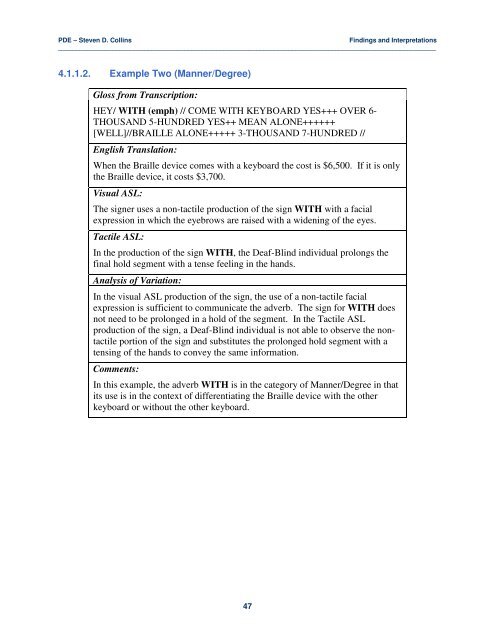Adverbial Morphemes in Tactile ASL - Gallaudet University
Adverbial Morphemes in Tactile ASL - Gallaudet University
Adverbial Morphemes in Tactile ASL - Gallaudet University
You also want an ePaper? Increase the reach of your titles
YUMPU automatically turns print PDFs into web optimized ePapers that Google loves.
PDE – Steven D. Coll<strong>in</strong>s<br />
F<strong>in</strong>d<strong>in</strong>gs and Interpretations<br />
_________________________________________________________________________________________________________<br />
4.1.1.2. Example Two (Manner/Degree)<br />
Gloss from Transcription:<br />
HEY/ WITH (emph) // COME WITH KEYBOARD YES+++ OVER 6-<br />
THOUSAND 5-HUNDRED YES++ MEAN ALONE++++++<br />
[WELL]//BRAILLE ALONE+++++ 3-THOUSAND 7-HUNDRED //<br />
English Translation:<br />
When the Braille device comes with a keyboard the cost is $6,500. If it is only<br />
the Braille device, it costs $3,700.<br />
Visual <strong>ASL</strong>:<br />
The signer uses a non-tactile production of the sign WITH with a facial<br />
expression <strong>in</strong> which the eyebrows are raised with a widen<strong>in</strong>g of the eyes.<br />
<strong>Tactile</strong> <strong>ASL</strong>:<br />
In the production of the sign WITH, the Deaf-Bl<strong>in</strong>d <strong>in</strong>dividual prolongs the<br />
f<strong>in</strong>al hold segment with a tense feel<strong>in</strong>g <strong>in</strong> the hands.<br />
Analysis of Variation:<br />
In the visual <strong>ASL</strong> production of the sign, the use of a non-tactile facial<br />
expression is sufficient to communicate the adverb. The sign for WITH does<br />
not need to be prolonged <strong>in</strong> a hold of the segment. In the <strong>Tactile</strong> <strong>ASL</strong><br />
production of the sign, a Deaf-Bl<strong>in</strong>d <strong>in</strong>dividual is not able to observe the nontactile<br />
portion of the sign and substitutes the prolonged hold segment with a<br />
tens<strong>in</strong>g of the hands to convey the same <strong>in</strong>formation.<br />
Comments:<br />
In this example, the adverb WITH is <strong>in</strong> the category of Manner/Degree <strong>in</strong> that<br />
its use is <strong>in</strong> the context of differentiat<strong>in</strong>g the Braille device with the other<br />
keyboard or without the other keyboard.<br />
47
















